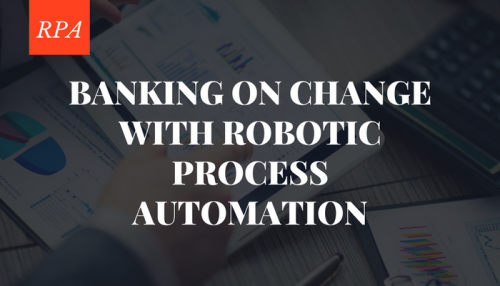Banking on Change with Robotic Process Automation
Blog: Kofax - Smart Process automation
Customer-first. Customer-centric.
We’ve heard these industry catch phrases so often they’ve become somewhat tedious, and it’s tempting to just tune them out. But the truth is, the meaning behind them matters. A lot. And never more so than when a financial services organization is trying to win—and retain—business from the tech-savvy digital consumer of today, especially the millennials.
Consider that, by 2020, the customer experience will overtake price and product as the key brand differentiator.[1] Whether they are opening a checking or savings account, applying for a first mortgage or seeking investment advice after the transfer of wealth from a parent or grandparent, this new generation of financial services customer has very clear expectations about their banking experience—which does not include navigating a lengthy manual application process or waiting days or weeks for an approval.
And, importantly, these consumers aren’t comparing your bank’s speed, agility or omnichannel offering to the one at a competing bank a few streets over; they’re comparing it to their digital experience with the hassle-free “instant gratification” online retailers like Amazon or eBay. In fact, a Bain report on retail banking revealed that customers conduct more than 50% of their banking interactions through digital channels in 18 of 22 countries surveyed.[2]
The situation is further complicated by the many mergers and acquisitions in the financial industry in recent decades; many financial service organizations continue to struggle with connecting disparate legacy systems and/or integrating manual processes in order to access the data they need to effectively serve customers. Customer service representatives (CSRs) often need to swivel between a dizzying array of applications, as well as access information from both internal and external data sources, to confidently address customer complaints and questions. Gathering and analyzing this data, while also striving to provide quick and timely customer service, can be difficult tasks for your employees.
Fortunately, adopting a flexible, integrated digital model can be the key to keeping your customers satisfied—enter robotic process automation (RPA).
Harnessing the Power of RPA for Better Customer Service
RPA uses “software robots” to automate the repetitive, mundane tasks of collecting and inputting data between portals, website, internal applications and bank systems. These robots aren’t metallic humanoids sitting at your desk. They are powerful software comprised of dynamic process flows. The end result: increased productivity and efficiencies, elimination of costly errors and freed up employees who can focus on more valuable work, including delivering better customer service and building loyalty.
No more will your customer service representatives spend the majority of their time manually gathering and inputting information between systems or trying to find customer data siloed in CRM, ERP and core banking systems. With RPA, these tasks can be streamlined and the time required cut in half, allowing your customer service representatives to do what they do best —serve and help your customers.
Worried about ripping up and replacing your current systems? RPA is not a core or backbone technology. It is complementary to your existing infrastructure, non-disruptive and scales easily. Software robots can be quickly and easily deployed to automatically run complex integrations across your email, call center applications and core bank systems—no coding required.
Unlocking the Potential of RPA
Leveraging software robots to improve the way you serve customers is an investment in the longevity and loyalty of your relationships—and the future of your bank.
In a recent recent J.D. Power study, Paul McAdam, Senior Director of Banking Services, stated: “Establishing customer service tools for competitive differentiation is key to a successful path forward. We clearly see that the customer satisfaction leaders in retail banking excel by hitting the sweet spot of providing a great digital experience backed by personal service.”competitive differentiation is key to a successful path forward. We clearly see that the customer satisfaction leaders in retail banking excel by hitting the sweet spot of providing a great digital experience backed by personal service.”[3]
Ready to dig deeper into the customer benefits of RPA? For more insights on how RPA can help you deliver a swift and seamless experience that builds customer loyalty, download your free e-Paper: Forecasting Your Future: How Financial Institutions Are Improving Operations: 3 Ways to Transform Your Business Using Robotic Process Automation.
References:
[1]Walker, Customers 2020
[2]Bain, Customer Loyalty in Retail Banking: Global Edition
[3]J. D. Power, U.S. Retail Banking Satisfaction Study
Leave a Comment
You must be logged in to post a comment.







